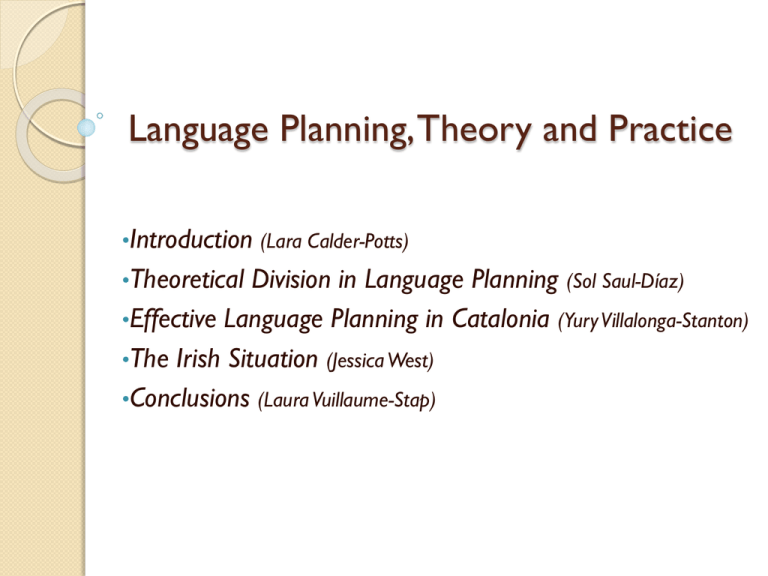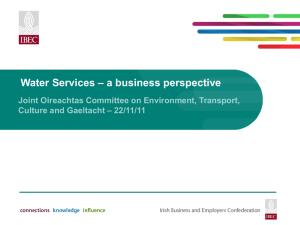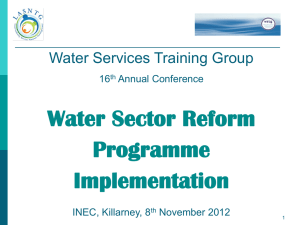
Language Planning, Theory and Practice
•Introduction (Lara Calder-Potts)
•Theoretical
Division in Language Planning (Sol Saul-Díaz)
•Effective Language Planning in Catalonia (Yury Villalonga-Stanton)
•The Irish Situation (Jessica West)
•Conclusions (Laura Vuillaume-Stap)
Language Planning,Theory and Practice:
INTRODUCTION
Language Planning
...is a deliberate effort to influence the function, structure
or acquisition of a language or language variety within a
speech community.
...is any political attempt to change the status of a
language in some way or develop new ways of using it.
Language Planning:
Goals
The desire for:
◦
◦
◦
◦
Unification;
Modernisation;
Democratisation;
Improved communication.
Decision making is motivated by:
◦
◦
◦
◦
Linguistic assimilation
Linguistic pluralism
Vernacularisation
Internationalisation
Language Planning:
Decolonisation and Minority Languages
‘Stable Diglossia’ - During the colonisation of Africa (c.
1652-1800) it was felt that a major European language
should be used in formal domains, while local languages
could serve other functions.
◦ Linguistic diversity was seen to impede national development
whereas linguistic homogeneity was linked to modernisation.
Decolonisation gave way to many developing nations,
within which the problems and processes of nationhood
became more apparent.
1960s – Language policy and planning research origins
◦ E.G. Joshua Fishman; Charles Ferguson.
“The key to successful nationhood is a combination of cultural
and ethnic unity, a defined geographical boundary and a
common linguistic identity among citizens.” (Fishman)
Language Planning:
The European Charter for Regional or Minority Languages
Post WWII Europe did not cultivate a favourable
environment for minorities.
1948 United Nations’ Universal Declaration of
Human Rights:
“Everyone is entitled to all the rights and freedoms set out in
this Declaration, without distinction of any kind, such as race,
colour, sex, language, religion, political or other opinion,
national or social origin, property, birth or other status.
Furthermore, no distinction shall be made on the basis of the
political, jurisdictional or international status of the country
or territory to which a person belongs, whether it be
independent, trust, non-self-governing or under any other
limitation of sovereignty.” (Article 2)
Language Planning:
The European Charter for Regional or Minority Languages
1976 - The International Covenant on Civil and Political
Rights extended the prohibition on language-based
discrimination.
1981 - Council of Europe adopted Recommendation 982 on
the Educational and Cultural Problems of Minority Languages
and Dialects in Europe.
23 June 1992 - Adoption of the Charter for European
Regional or Minority Languages with 5 abstentions but no
oppositions .
The Charter’s Preamble:
◦ Part I – General provisions
◦ Part II – Objectives and principles
◦ Part III – Measures to promote the use of regional or minority
languages in public life
◦ Part IV – Application of the Charter
◦ Part V – Final Provisions
Language Planning,Theory and Practice:
THEORETICAL
DIVISION IN
LANGUAGE PLANNING
Language Planning:
Theoretical Division
Theoretical Linguistics’ core fields are:
◦
◦
◦
◦
Syntax;
Phonology;
Morphology;
Semantics.
Theoretical Linguistics is also concerned
with the search for an explanation of
linguistic universals.
Language Planning:
Extended Definition
Language Planning is often associated with
government planning, but is also used by a variety
of NGOs
Authorities must recognise ethical and moral as well
as linguistic obligations when making
recommendations
Planning decisions made for the benefit
of communication can lead to other social changes
such as language shift or assimilation
Different types of Planning:
◦ Status
◦ Corpus
◦ Acquisition
Language Planning:
Status Planning
...is the allocation or reallocation of a language or
variety to functional domains within a society, thus
affecting the status, or standing, of a language.
Important societal domains:
◦
◦
◦
◦
◦
◦
◦
Government;
Assembly/Parliament;
Courts;
Administration;
Education;
Business;
Media.
Language Planning:
Corpus Planning
...refers to the prescriptive intervention in the forms
of a language, whereby planning decisions are made
to engineer changes in the structure of the
language.
Three groups of Corpus Planning:
◦ Graphisation
◦ Standardisation
◦ Modernisation
Language Planning:
Acquisition Planning
... is a type of language planning in which a national, state
or local government system aims to influence aspects of
language, such as language status, distribution and literacy
through education.
The Education Sector’s six principal goals:
◦ To decide what languages should be taught within the
curriculum
◦ To determine the amount and quality of teacher training
◦ To involve local communities
◦ To determine what materials will be used and how they
will be incorporated into syllabi
◦ To establish a local and state assessment system to
monitor progress
◦ To determine financial costs.
Language Planning,Theory and Practice:
EFFECTIVE LANGUAGE
PLANNING IN
CATALONIA
Language Planning:
Key Dates in Catalan Linguistic History
1970 – 78: Prohibition in teaching minority languages
disappears.
◦ Ley General de Educación (4-8-1970)
◦ Decreto 1433/ 1975 30th May
1978 – 79 &1981 - 82: Approved ‘Estatut d’Autonomia’.
◦ Real Decreto: 2092/ 1978 23rd June
◦ Ley Orgánica 4/1979 18th December: ‘Estatut de Catalunya’
establishes article 3:3
“La Generalitat garantizará el uso normal y oficial de ambos idiomas,
tomará las medidas necesarias a fin de asegurar su conocimiento y
creará las condiciones que permiten llegar a su igualdad plena en
cuanto a los derechos y deberes de los ciudadanos de Cataluña.”
1982 – 83: “…establecimiento generalizado del catalán como
lengua vehicular de aprendizaje en los centros docentes no
universitarios…”
NB: None of this was not normativised until Decreto
270/1982 5th August
Language Planning:
Difficulties incorporating Catalan into Education System
“La situación de precariedad de la lengua catalana en el ámbito
territorial que le es propio, fruto de una política de aniquilación y
de marginación oficiales, es el primero que es preciso señalar.”
“La imposibilidad del aprendizaje ordenado de la lengua y, como
consecuencia, el desconocimiento del catalán escrito por parte de
la mayoría de la población adulta catalanohablante.”
“La carencia de medios de comunicación y la supresión del
catalán de la vida oficial o administrativa son hechos largamente
evidenciados que han hecho temer a los sociolingüistas por la
supervivencia del idioma.”
(Siguan)
Language Planning:
Historical Factors in the Catalan Recovery
1943: Benèfica Minerva founded by Fèlix Millet i Maristany
was dedicated to Catalan patronage
1961: Comissió delegada de l’Ensenyament del Català
1961: Junta Assessora per als Estudis del Català (JAEC)
1967: Delegació d’Ensenyament Català (DEC)
1975: Escola de Mestres Rosa Sensat
1978 – 79: School introduced partial teachings of Catalan
Diputación de Barcelona
Diputación de Lérida created ‘Càtedra de Llengua Gili Gaya’
City Council of Barcelona subsidized Catalan classes
Many universities ran courses in Catalan via Instituts de
Ciències de l’Educacio before the language was officially
encouraged to be taught.
Language Planning:
Normativising Catalan
“En el último tercio de siglo XIX, el incremento de la literatura en catalán y los diversos
esfuerzos colectivos por su restauración hicieron la necesidad urgente de su fijación
ortográfica, morfosintáctica y léxica, así como de normalizar su uso en los diversos ámbitos
de la vida social, pues la lengua, desde el siglo XV, había quedado al margen de los grandes
procesos de normalización que se llevaron a cabo en la constitución de las distintas lenguas
estándar europeas.”
1796: First attempts were mentioned in Diario de Barcelona
1815: “...codificación de la ‘Gramática i apologia de la llengua
catalana’.”
1890-1892: “…el grupo desplegó una campaña lingüística
proponiendo la fijación literaria de la lengua, sin que supusiera un
desacuerdo grande entre escrita y la hablada.”
1918: Pompeu Fabra published ‘Ensayo de gramática del
catalán moderno’.
Language Planning:
The Effort to Normalise and The Golden Age
1901: La Lliga Regionalista; Enric Prat de la Riba
1907: Institut d’Estudis Catalans created
1931: Catalan was seen for the first time as a coofficial language
Valencia & the Balearics did not acheive the same
level of linguistic normalisation
Successful publications in Catalan included;
La Veu (1899 - 1937)
El poble Català (1906 - 1918)
La Publicitat (1922 - 1939)
Estudis Universitaris Catalans (1907 - 1930)
Taula de les Lletres Valencianes (1927 – 1930)
Eugeni d’Ors – considered by some to be one of the
most influential modern Catalan writers
Language Planning:
Normalising and Normativising Catalan
In 1906 the Congrés Internacional de la Llengua
Catalana proclaimed Catalan as a ‘lengua
diferenciada’ and proposed valid regulations for all
of its speakers
◦ Institut d’Estudis Catalans and the Sección Filológica –
overseen by Antoni María Alcover and, later, Pompeu
Fabra
Fabra used support from the institute to further
his studies;
◦
◦
◦
◦
Normes Ortográfiques (1913)
Exposició de l’ortografia catalana (1917)
Gramática catalana (1918)
Diccionari general de la llengua catalana (1932)
2nd edition by Carles Riba was published in 1954
Language Planning:
Catalan and the Dictatorship
During the dictatorship Catalan was prohibited in
the educational and administrative sectors with a
complete eradication of its use in newspapers,
radios, political and cultural institutions, and
became de-officialised.
During the 1950s and ‘60s, with church assistance,
some publications like ‘Serra d’Or’ (1959),
‘Oriflama’ (1961 – 1967) and ‘Lluc’ (1968) were
made available.
In Mallorca, Francesc de Borja Moll and Sanchis
Guarner published ‘Diccionari Català-ValenciàBalear’ (1949 – 1962) which was legally recognised
by the association Obra Cultural Balear.
Language Planning,Theory and Practice:
THE IRISH SITUATION
Language Planning:
Irish - Background Information
Irish was originally dropped for English between 1750 and
1850
1851 saw the first census to take account of language
◦ 5% see themselves as monolingual
◦ 23% described themselves as bilingual
There was no future in Irish
Irish writers attempted to transpose the flavour and rhythm
of the Irish language into their prose written in English
A strong feeling remained that Ireland was a distinct nation
and the nineteenth century saw Irish nationalism flourish
Sense of continuity with the past maintained
“[English has been] completely indigenised [in Ireland] and
associated with a new indigenous Great Tradition.” (Fishman 1968,
footnote 16)
Language Planning:
The Gaelic League
Decline of Irish was regrettable and the end of the 18th C.
saw sporadic efforts to stem this
At the end of 19th C., a language-revival movement spread
through Ireland as promoted by the Gaelic League
◦ “De-Anglicization” of Ireland
◦ Initial linguistic plan: “...to maintain Irish as a spoken language in
Ireland.”
◦ Public image and propaganda of the league: to foster Irish as the
national language of Ireland and to spread its use as a spoken
language
After an unremarkable start, the League suddenly caught the
popular imagination and attracted wide support
◦ 1893 – the idea was born
◦ 1901 – 120 branches
◦ 1904 – 593 branches
Language Planning:
The Gaelic League cont’d
The main strategy saw adult classes, public lectures, pamphlets,
parades and popular competitions and satire
The League received the support of people from every political
group, religious denomination and social class
By 1905, the League’s successes were already impressive:
◦
◦
◦
◦
◦
Attending classes had become popular;
An Claidheamh Soluis was started;
The foundations of modern literature had been laid;
Popular interest in Gaelic literature, music, and customs;
The British Postmaster General had been forced to accept mail
addressed in Irish;
◦ The Dublin County Council began to give preference to candidates who
knew Irish;
◦ Many primary schools and some secondary schools and teacher-training
colleges had been persuaded to introduce Irish.
Climax of the League’s progress was the successful inclusion of
Irish, as a subject, in the matriculation requirements for the new
National University of Ireland
Language Planning:
The Gaelic League cont’d
1922 establishment of the Irish Free State
◦ Following the establishment of the Free State, the League felt
that the main responsibility for the restoration of Irish lay with
the young government
Commission on the Revival of Irish: “It stands to reason that
people’s enthusiasm should have waned as soon as the war with
England was ended, and since the cultivation of the language was
seen as part of that war it was natural that their devotion should
diminish.”
In an Irish state there was no need for the League to engage
in work for the language
Following the end of the civil war, the zeal for the language
faded owing to a bitterness over the cruelty of the civil war
The civil war was succeeded by the Great Depression of the
1920s and then by the World War; during these years the
restoration movement seemed to make great progress.
There was, however, a distinct lack of enforcement
Language Planning:
Education – Primary Level
Legislation dictated “...that the Irish language be taught,
or used as a medium of instruction, for not less than one
full hour each day in all national (primary) schools where
there was a teacher competent to teach it.”
1925 – the use of Irish as a medium be extended “as
far as possible”
1934 – the above was made obligatory on all school
teachers
Number of primary schools teaching exclusively in
Irish fell over time:
◦
◦
◦
◦
1939 – 704
1944 – 601
1956 – 389
1966 – 309
Language Planning:
Education – Secondary & Third Level
Secondary Education
25% increase on capitation grants
10% bonus in exams
Between 1944 and 1968 there was a decline in the number
of grammar schools that taught subjects in Irish
◦
◦
◦
◦
◦
1944 – 98 out of 377 taught all subjects in Irish (excl. English)
1951 – 54% taught wholly or partly in Irish
1956 – 87 out of 474 taught in Irish
1966 – 72 out of 585
1968 – 51 out of 596
Third Level Education
All university colleges offer courses in Irish language and
literature, but only Galway seriously attempts to offer, in the
arts and sciences, courses that are taught and examined in
Irish
Language Planning:
Standardisation of Irish
1945 onwards saw the first steps towards the
standardisation of Irish:
◦ The translation office produced a simplified spelling
(1945)
◦ In 1953, the translation office produced a new and
simplified grammar
◦ In 1959, the new Irish dictionary aimed to “...provide
Irish equivalents for English words and phrases in
common use.”
Language Planning:
Other Aspects of Irish Life
1937 Constitution – “The Irish language as the national
language is the first official language. The English language is
recognised as the second official language.” (Article 8)
1958 Commission for progress
“What we understand by the Revival [restoration] is that the
[Irish] language should once again be a normal means of
conversation and communication among Irish people. This has
been the objective of the Irish language movement from its
inception and of the political movement which stemmed from it,
and this has been the linguistic objective of every government
since the foundation of the State.” (p.xiii)
In the years since the commission’s report, the government
has issued a white paper on restoration policy and two
progress reports (1965, 1966, 1969)
However, progress has been rather disappointing.
Language Planning:
Other Aspects of Irish Life
Parliamentary business is transacted in English
All civil servants are required to know Irish at
the time of their recruitment
The Irish Army trains its officers mainly in Irish
Recruits for state police are required to have
some knowledge of Irish
All lawyers, before qualifying, are required to give
evidence that they know Irish
The state runs television and radio and requires
both to present some programmes in Irish
◦ 7.8% of the time on television and 3.8% of the time
on radio is taken up with programmes exclusively in
Irish
Language Planning:
Other Aspects of Irish Life
Businesses
Many of the large businesses have made an effort
to foster Irish
The Catholic Church
95% of people in the Republic of Ireland are
Catholics, however the Church as an institution
remained aloof from the restoration issue for a
long time.
The Dublin regulation states there should be one
‘Irish’ Mass in each church every Sunday
The feebleness of the restoration movement has
been frequently attributed to the lack of
ecclesiastical support
Language Planning
The Irish Situation - Conclusions
Irish will not become the principal language of the country
1964 – Irish Marketing Surveys Ltd poll of attitude towards Irish yielded
83% of the population did not think that Irish could be restored as the
most widely spoken language
The 1965 white paper acknowledges that the country is dependent and
will continue to be dependent on a knowledge of English
However, it would be wrong to conclude that the Irish people wish to
drop Irish all together – 76% questioned by the Irish Marketing Surveys
said they would like to see Irish widely spoken as a second language
Linguistic objectives have been stated in relative ignorance of how the
people felt about them
Lack of clear purpose – No attempt has been made to measure progress
Absence of long and short term objectives and of thorough evaluation
means that there is no machinery for deciding when the movement as a
whole is successful or when it should be dropped if failing
English vs. Irish – As a language of culture and of commerce English is
invaluable to the Irish people and provides a means to the world of
business and capitalism.
Lack of real enthusiasm for bilingualism
Language Planning,Theory and Practice:
CONCLUSIONS
Language Planning:
Conclusions - Recap
Language planning is a deliberate effort to influence the
function, structure, or acquisition of a language or
language variety within a speech community.
Often associated with government planning, but is also
used buy a variety if non-governmental organisations.
The goals of language planning differ depending on the
nation or organisation, but generally include making
planning decisions and possibly changes for the benefit
of communication.
Planning or improving effective communication can also
lead to other social changes, such as language shift or
assimilation, thus providing another motivation to plan
the structure, function and acquisition of language.
Language Planning:
Conclusion of the effectiveness of Catalan and Irish
planning
When comparing Catalan and Irish it is possible to conclude that Catalan
language planning has been more effective. Although both languages have
needed to be revived, governmental and ecclesiastical organisations took more
responsibility in the case of Catalan.
Catalan has gained status as well as users and a large part of the Catalan
government’s Catalanisation policy, which must be said to have been carried
out skilfully in its insistence on consensus and negotiation, has encountered
widespread support.
It could be argued that it is no longer necessary to implement language policies
in order to support Catalan identity – this identity is already quite well
established and for many Catalan-Castilian bilinguals - their linguistic and
cultural ascription is probably a similarly hyphenated one.
On the other hand, the Irish language could be said to remain under threat.
Although the League declared that Irish must be the language of instruction for
at least one hour in primary schools nationwide.
The program implementation was mostly left to the individual schools, which
did not consistently adhere to the program’s rules. Educating a generation is a
long process for which the League was not prepared.
Language Planning:
Conclusion of the effectiveness of Catalan and Irish
planning
There was no general consensus as to how Irish should
be reinstituted and system assessment plan to monitor
progress and the people’s desires was lacking.
As a result, the movement lost strength and English
remains the nation’s second official language and most
spoken first language, leading to the considerable failure
of Ireland’s attempt at language revitalisation.
Language Planning, Theory and
Practice
A bibliography for this presentation will be available as a
separate document.
PowerPoint© Presentation by Rai Furniss







